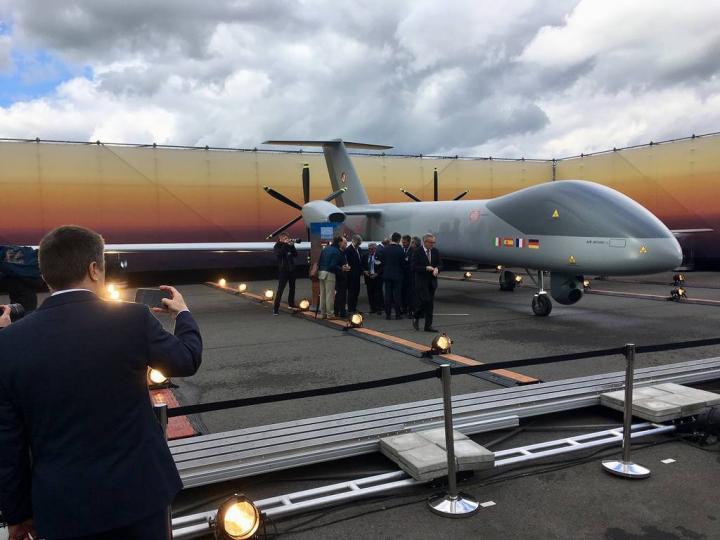4.12.2021

Companies are jockeying for position to supply engines for the Eurodrone, a mockup of which was unveiled at the 2018 Berlin Air Show. (Sebastian Sprenger/Staff)
ROME – As Airbus awaits a sign-off on its new European drone, a U.S.-owned Italian firm and a French company are on tenterhooks to discover who has been picked to supply the engine.
Italy’s Avio Aero and France’s Safran Helicopter Engines are waiting on the last big decision that needs to be made about the Eurodrone, and are keenly pointing out why they are the best choice.
The propulsion decision will be made right after the four partner nations on the program, Italy, France, Germany and Spain, sign off on the Airbus-led project in the next couple of months, an Airbus official said this week.
With Spain reportedly set to add the last signature required, the twin-engined, 98-foot wingspan MALE drone is edging closer to becoming reality after months of delay.
Which leaves Avio Aero, which is owned by GE, and Safran Helicopter Engines, touting their wares, with the French firm keenly stressing the all-European pedigree of its proposed Ardiden STP engine.
“With the Ardiden 3TP, we have assembled a 100% European team, we are committed to deliver a 100% European engine featuring high levels of design maturity and competitive operating and maintenance costs,” said Florent Chauvancy, Safran Helicopter Engines EVP OEM Sales.
The firm has partnered with European firms ITP Aero, Piaggio Aerospace and ZF Aviation Technology to develop the Ardiden 3TP from its EASA-certified Safran Ardiden 3 engine core.
But the stress on who is the most European of the rivals has irked Italy-based Avio Aero, which was purchased by GE in 2013.
“The French press has criticized us, but our product was developed in Europe with European technology and there are no U.S. controls on exports,” said Paolo Salvetti, sales director for military turboprop engines.
Avio Aero is offering a variant on its Catalyst engine now being developed for the Beechcraft Denali aircraft. The Catalyst flew on a King Air test bed in September and on a Beechcraft a week ago after 2,700 hours of ground testing. “If we win, we would only need to make a few changes to integrate it - we are the more mature product,” said Salvetti.
“I expect Airbus to make its decision based on price, risk and technology,” he said.
In a statement to Defense News, Safran Helicopter Engines described the Ardiden 3, on which its drone offering will be based, as a “mature program”, noting that two EASA-certified models, the Ardiden 3C and 3G have completed over 10,000 hours of ground tests and 2,500 hours of flight, while the Russian Ka-62 helicopter, which uses the 3G, has now been certified.
Avio Aero’s Salvetti said an engine developed from an aircraft propulsion design, like the Catalyst, rather than a helicopter design, could be better suited to the high altitudes at which a MALE drone flies.
That was “unfounded,” Safran Helicopter Engines responded.
“Compared to the helicopter variants, the Ardiden 3TP incorporates technologies that will ensure a high level of performance at medium and high altitudes, up to 45,000 feet,” the firm said.
Quelle: DefenseNews

